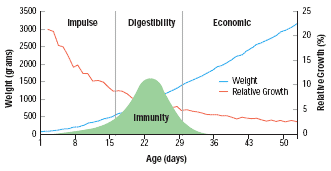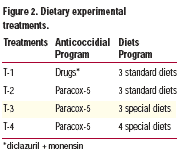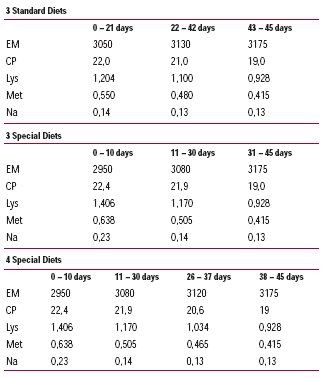Nutrition Notebook: Idea
Changing Paradigms in poultry nutrition and performance
 Dr. Joaquim Brufau
IRTA Research Institute, Spain |
The success of a broiler operation, particularly its profitability, is very dependent on how well the bird's intestinal tract is functioning. Traditionally, intestinal health has been highly dependent on drugs, but today's emphasis on raising birds with fewer drugs and the increased use of coccidiosis vaccination has changed the situation.
The focus now must be on establishing immunity early to help birds express their maximum potential for growth and feed efficiency. In modern broilers, attention to the first weeks of life is critical for optimal performance later. During this time, high quality nutrients are needed to ensure the development of immunity and proper tissue building in the intestinal tract.
In the third and fourth weeks of life, birds are continuing to develop immunity against intestinal disease and still require good nutrition. The relative growth period remains good and should be maximized. Fortunately, this need for special attention to nutrition comes at a time when the volume of feed consumed is relatively small.
After the fourth week of life, the relative growth potential is lower, but feed consumption is higher. If immunity is not completely established, feed efficiency is not maximized. Figure 1 demonstrates the objective of an efficient management program for intestinal health that is based on early development of immunity and enabling birds to express optimal growth and feed efficiency.
IDEA Program objectives
To help producers maximize nutrition and performance in broilers vaccinated with Paracox-5, Schering-Plough Animal Health Corporation has developed the IDEA Program.
It is based on the physiology of the bird and the development of immunity to intestinal pathogens.
Its objectives follow:
 Figure 1. Growth curve, relative growth and timing to maximize efficiency of the immunity process. |
I "� Impulse.
During the first 2 weeks of life, the goals are to prepare birds for immunity development, optimize development of the intestinal tract and immunity, provide nutrition that guarantees good development of bones and muscles, and take advantage of the high growth potential.
D "Digestibility.
During the third and fourth weeks of life, the goals are to maintain intestinal mucosa integrity, reduce exposure to harmful bacteria and guarantee good immune system function.
E "� Economic.
This part of the IDEA Program is intended to capitalize on compensatory gain and reap the economic advantages that are possible as a result of strong immunity and maximum growth potential.
A "Advance.
 Figure 2. Dietary experimental
treatments |
The IDEA Program helps poultry businesses operate more efficiently at time when resistance to
traditional anticoccidials has developed and there are limitations or bans on the use of in-feed growth-promoting antibiotics.
IDEA provides producers with a model that is not dependent on the use of drugs to maintain good intestinal health.To demonstrate the importance of the IDEA concept, Schering-Plough Animal Health initiated a series of trials, which are detailed below.
Trial 1
This trial was initiated in partnership with the IRTA Research Institute, Spain, to assess the IDEA Program in Paracox- 5 vaccinated birds and traditional nutrition in anticoccidial-treated birds. Figure 2 shows the trial protocol. Figure 3 shows details of the diets provided to birds in the trial.
 Figure 3. Feed formulation and composition for birds in Trial 1. |
Trial 1 results
The results, shown in Figures 4, 5 and 6, demonstrate that vaccinated chickens that received a more digestible diet also designed to improve development of the intestinal tract and immune system during the first 4 weeks of life "the Impulse and Digestive phases of the IDEA Program "had the best growth and feed conversion compared to other groups in the trial.
By the end of the trial, all groups had similar performance. The results may not be the same on farms with high density and sanitary and environmental challenges, but an improvement in performance should still be achieved from the Impulse/Digestive phase (0 to 28 days).
Trial 2
A second trial performed at IRTA in partnership with SPAH assessed the IDEA concept in birds grown to a younger age. Traditionally, coccidiosis vaccination has been considered unfeasible in birds grown to a younger age because they would not have as much time after development of immunity to attain maximum growth and feed efficiency. The Trial 2 protocol is shown in Figure 7 and the feed formulation and composition in Figure 8.
Trial 2 results
As Figures 9 and 10 show, vaccinated chickens demonstrated better performance than drug-treated chickens until day 28 (the Impulse and Digestive phase of the IDEA Program). Final weight and performance in the trial were similar in all groups. Remember that vaccinated birds in the trial hadbetter performance during the initial period of growth.
Trial 3
A third trial assessed the effects of four rations with different combinations of nutritional concentrations during days 15 to 28. Its purpose was to determine if it is possible to have a compensatory response in the final phase of the feeding program.
All chickens in the trial were vaccinated with Paracox-5. One of the rations included a highly digestible protein source. Traditionally, it has been thought that protein levels should be reduced to reduce exposure to harmful bacteria.
 Figure 4: Performance from 0 to 28 days. |
 Figure 5: Performance from 0 to 37 days. |
 Figure 6: Performance from 0 to 45 days. |
Trial 3 results
The details of Trial 3, which are available from Schering-Plough Animal Health, showed that reducing crude protein levels during the third and fourth weeks of life "the digestibility phase "has a negative impact on performance and that compensatory gain was not seen until 36 days. On the other hand, increasing crude protein levels during this time, since the ingredient has high digestibility, improves performance without increasing exposure to harmful bacteria. Increasing the digestibility of the protein fed was highly beneficial, even when the total protein fed was lower.
The trial also showed that a good concentration of nutrients during the first 4 weeks of life is very important for maintaining the integrity of intestinal mucosa. It appears to be more useful than increasing energy levels later in an attempt to take advantage of the compensatory gain.
 Figure 7: Protocol for Trial 2.
|
 Figure 8: Feed formulation and composition for birds in Trial 2. |
General conclusions
Trials have demonstrated that the IDEA Program helps develop and maintain the integrity of intestinal mucosa. The
IDEA approach promotes improved nutrition early in life and yields performance just as good as the performance
of unvaccinated birds receiving traditional anticoccidial treatment. IDEA can enable poultry producers to get the
most from Paracox-5 vaccinated birds.
Trial 3 shows that performance is enhanced if digestibility of the protein
fed is improved during the time that immunity is developing. It has shown to be more important than altering levels
of crude protein.
Schering-Plough Animal Health is committed to working with the poultry industry toward the goal of finding
additional opportunities for further improvement in cost-effective nutrition for broilers.
 Figure 9: Performance in Trial 2 birds from 0 to 28 days. |
 Figure 10: Performance in Trial 2 birds from 0 to 36 days. |
Source: CocciForum Issue No.9, Schering-Plough Animal Health.







